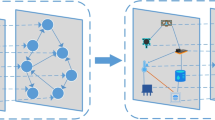Abstract
Anomaly detection stands as a crucial facet within the domain of data quality assurance. Notably, significant strides have been made within the realm of existing anomaly detection algorithms, encompassing notable techniques such as Long Short-Term Memory (LSTM), Gated Recurrent Unit (GRU), and anomaly detection models founded upon Generative Adversarial Networks (GANs). However, a notable gap lies in the inadequate consideration of interdependencies and correlations inherent in multidimensional time-series data. This becomes particularly pronounced within the context of industrial evolution, where industrial data burgeons in complexity. To address this lacuna, a novel hybrid model has been introduced, synergizing the capabilities of GRU with structural learning methodologies and graph neural networks. The model capitalizes on graph structural learning to unearth dependencies linking data points across distinct spatial dimensions. Concurrently, GRU extracts temporal correlations embedded within data along a single dimension. Through the incorporation of graph attention networks, the model employs a dual-faceted correlation perspective for data prediction. Discrepancies between predicted values and ground truth are utilized to gauge errors. The amalgamation of predictive and scoring mechanisms enhances the model’s versatility. Empirical validation on two authentic sensor datasets unequivocally demonstrates the superior efficacy of this approach in anomaly detection compared to alternative methodologies. A notable augmentation is observed particularly in the recall rate, underscoring the method’s potency in identifying anomalies.
Access this chapter
Tax calculation will be finalised at checkout
Purchases are for personal use only
Similar content being viewed by others
References
Zhao, P., Chang, X., Wang, M.: A novel multivariate time-series anomaly detection approach using an unsupervised deep neural network. IEEE Access 9, 109025–109041 (2021)
Schmidl, S., Wenig, P., Papenbrock, T.: Anomaly detection in time series: a comprehensive evaluation. Proc. VLDB Endow. 15(9), 1779–1797 (2022)
Amarbayasgalan, T., Pham, V.H., Theera-Umpon, N., et al.: Unsupervised anomaly detection approach for time-series in multi-domains using deep reconstruction error. Symmetry 12(8), 1251 (2020)
Deng, A., Hooi, B.: Graph neural network-based anomaly detection in multivariate time series. In: Proceedings of the AAAI Conference on Artificial Intelligence, vol. 35, no. 5, pp. 4027–4035 (2021)
Guan, S., Zhao, B., Dong, Z., Gao, M., He, Z.: GTAD: graph and temporal neural network for multivariate time series anomaly detection. Entropy 24(6), 759 (2022)
Zhou, H., Yu, K., Zhang, X., et al.: Contrastive autoencoder for anomaly detection in multivariate time series. Inf. Sci. 610, 266–280 (2022)
Almardeny, Y., Boujnah, N., Cleary, F.: A novel outlier detection method for multivariate data. IEEE Trans. Knowl. Data Eng. 1 (2020). https://doi.org/10.1109/tkde.2020.3036524
Pasini, K., Khouadjia, M., Samé, A., et al.: Contextual anomaly detection on time series: a case study of metro ridership analysis. Neural Comput. Appl. 34(2), 1483–1507 (2022)
Niu, Z., Yu, K., Wu, X.: LSTM-based VAE-GAN for time-series anomaly detection. Sensors 20(13), 3738 (2020). https://doi.org/10.3390/s20133738
Lee, C.K., Cheon, Y.J., Hwang, W.Y.: Studies on the GAN-based anomaly detection methods for the time series data. IEEE Access 9, 73201–73215 (2021)
Bashar, M.A., Nayak, R.: TAnoGAN: time series anomaly detection with generative adversarial networks. In: 2020 IEEE Symposium Series on Computational Intelligence (SSCI), pp. 1778–1785. IEEE (2020)
Xu, L., Xu, K., Qin, Y., et al.: TGAN-AD: transformer-based GAN for anomaly detection of time series data. Appl. Sci. 12(16), 8085 (2022)
Wu, W., He, L., Lin, W., et al.: Developing an unsupervised real-time anomaly detection scheme for time series with multi-seasonality. IEEE Trans. Knowl. Data Eng. (2020)
Chen, L.J., Ho, Y.H., Hsieh, H.H., et al.: ADF: an anomaly detection framework for large-scale PM2. 5 sensing systems. IEEE Internet Things J. 5(2), 559–570 (2017)
Guo, Y., Liao, W., Wang, Q., et al.: Multidimensional time series anomaly detection: a GRU-based gaussian mixture variational autoencoder approach. In: Asian Conference on Machine Learning, pp. 97–112. PMLR (2018)
Tang, C., Xu, L., Yang, B., et al.: GRU-based interpretable multivariate time series anomaly detection in industrial control system. Comput. Secur. 103094 (2023)
Zong, B., et al.: Deep autoencoding Gaussian mixture model for unsupervised anomaly detection. In: International Conference on Learning Representations, February 2018
Park, D., Hoshi, Y., Kemp, C.C.: A multimodal anomaly detector for robot-assisted feeding using an LSTM-based variational autoencoder. IEEE Robot. Autom. Lett. 3(3), 1544–1551 (2018)
Li, D., Chen, D., Jin, B., Shi, L., Goh, J., Ng, S.-K.: MAD-GAN: multivariate anomaly detection for time series data with generative adversarial networks. In: Tetko, I.V., Kůrková, V., Karpov, P., Theis, F. (eds.) ICANN 2019. LNCS, vol. 11730, pp. 703–716. Springer, Cham (2019). https://doi.org/10.1007/978-3-030-30490-4_56
Acknowledgments
This work was supported by the National Key R &D Program of China under Grant No. 2020YFB1710200. The datasets are provided by iTrust, Centre for Research in Cyber Security, Singapore University of Technology and Design.
Author information
Authors and Affiliations
Corresponding author
Editor information
Editors and Affiliations
Rights and permissions
Copyright information
© 2024 The Author(s), under exclusive license to Springer Nature Singapore Pte Ltd.
About this paper
Cite this paper
Lu, D., Li, S., Zhao, Y., Han, Q. (2024). Anomaly Detection of Industrial Data Based on Multivariate Multi Scale Analysis. In: Jin, H., Yu, Z., Yu, C., Zhou, X., Lu, Z., Song, X. (eds) Green, Pervasive, and Cloud Computing. GPC 2023. Lecture Notes in Computer Science, vol 14503. Springer, Singapore. https://doi.org/10.1007/978-981-99-9893-7_7
Download citation
DOI: https://doi.org/10.1007/978-981-99-9893-7_7
Published:
Publisher Name: Springer, Singapore
Print ISBN: 978-981-99-9892-0
Online ISBN: 978-981-99-9893-7
eBook Packages: Computer ScienceComputer Science (R0)




